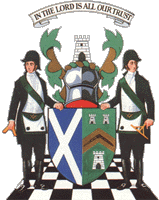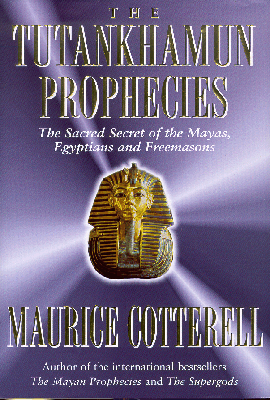


| Review | 
|
As always the word 'Freemasons' on the cover of this book (and a very eye-catching cover it is) ensured that I bought this book. Over the years I have found it extremely difficult to stand in a book shop and read, in detail, the bits that interest me, so I end up buying the book in order to analysis the contents properly. I strongly suspect that the publishers and graphic designers know exactly how to entrap the likes of me!
 The main difficulty in reviewing a book such as this is simply wading through the morass of detail and the author's attempt to link it altogether into one coherent 'story'. The subject matter covered ranges from the Mayas of Central America (c.700 - c.1100); the Egyptians (c.30000bc - 641ad); Tutankhamun (1336-1327 BC.); U.F.O.'s; The Knights Templar; Freemasonry; Sun Spots and how these cause cancers, schizophrenia, affect the rise and fall of civilisations, the human Foetus and the control of the Honey Bee. In this attempt the author fails.
The main difficulty in reviewing a book such as this is simply wading through the morass of detail and the author's attempt to link it altogether into one coherent 'story'. The subject matter covered ranges from the Mayas of Central America (c.700 - c.1100); the Egyptians (c.30000bc - 641ad); Tutankhamun (1336-1327 BC.); U.F.O.'s; The Knights Templar; Freemasonry; Sun Spots and how these cause cancers, schizophrenia, affect the rise and fall of civilisations, the human Foetus and the control of the Honey Bee. In this attempt the author fails.
Whilst the reviewer would wish to comment on the author's particular interpretation of Mayan and Egyptian history, culture and artefacts it is not possible to do so here. Throughout the book the author makes dismissive remarks regarding 'orthodox' (i.e. 'unimaginative') authorities on the various. The flyleaf of the book provides an insight: "His work, best described as adventure fact… ". I am not sure what 'adventure fact' means but it is obviously not 'fact'. The author omits to provide any references to the 'experts and I shall, therefore, provide some information regarding these unknown experts at the end of this review. Most frustrating is the author's constant references to his previous books implying that unless these have been read one cannot understand, fully, what he is saying. And so to the book itself:
As a Scottish Freemason, and proud of it, the reviewer must immediately address the author's comments regarding Freemasonry. It is clear that he knows very little about Freemasonry, its recorded history and development. He begins with that well-worn myth that the Knights Templar were, and are, the precursors of modern Freemasonry. In this book that myth is taken a wee bitty further: "Lower ranking Freemasons are led to believe their pedigree begins with the Knights Templar…" He then goes on to give a 'potted history' of the Knights Templar and then 'proves' the link with modern Freemasonry by stating: "the initiation of apprentice Freemasons, which involves the stabbing of the air with a dagger to avenge the killers of de Molay". Well there you have it, positive 'proof' that Freemasonry derives from the Knights Templar!
When the author attempts to discuss, more specifically, Masonic custom and practice he displays an ignorance of the subject. This ignorance is manifest in numerous instances and a few quotes shall suffice to indicate this:
"Two pillars at the entrance [of King Solomon's Temple], one Doric, one Corinthian, represented the duality of severity and mercy… this explains the symbolism of the two columns and temple featured in Masonic regalia",
"The lion, with its raised paw, became one of the most revered symbols of Freemasonry" and,
"The (original) Freemasons' ceremonial apron is, ideally, made of a square of white lambskin measuring 144 square inches".
It is impossible to know where the author obtained his information for he fails to quote many sources when making such assertions. The errors in the book regarding Freemasonry serve also to show that the author assumes, as many others have, that the sources (those that are quoted) are definitive. No one individual, or group of individuals, speaks for Freemasonry. Many offer their opinions but they remain opinions only. This basic fact escapes the author (and many others) and again indicates an ignorance of the nature of Freemasonry. To this point the author has offered a fairly standard, if quite erroneous, explanation of the history and meaning of Freemasonry. All is simply a rehash of material printed previously. It was the latter part of Chapter Five (Behind the Wall of Silence) that was something of a surprise. The penultimate part of the Chapter is sub-headed: "From Ceremony to Free Flight: The Secret Weapon of the Masons…" The last part is sub-headed: "How Masons Read Minds". I shall quote, at length, from the former (pp 226-7)
"Only the Thirty-Third Degree masons are true Freemasons and, like the Mahatmas of India, super-human. Like the Rosicrucians, with their 'Casting of the Molten Sea', 'The Making of the Rose Diamond' and 'The Achieving of the Philosopher's Stone', they are capable of out-of-body experiences. The method of Thirty-Third Degree Freemasons in scaling these heights is through what they call 'the cable tow', a mythical silver thread that, with practice, extends from the navel. The journeying soul can leave the body providing the higher intellect holds this umbilical cord tight, to provide a return to the body. The practice is dangerous, as breakage of the cable tow precludes return to the body, and this is the ultimate reason for the secrecy of the Thirty-Third Degree Masons and is referred to in the Bible:'… man goeth to his long home, and mourners go about the streets: or ever the silver cord [cable tow] be loosed or the golden bowl [halo] be broken… then shall the dust return to the earth as it was; and the spirit shall return to God who gave it' (Ecclesiastes, xii, 5-7)".
The second part does NOT explain "How Masons Read Minds" but rather how an individual might read the mind of another.
The whole Chapter on Freemasonry is so riddled with errors, and very strange ideas, that there is no substantive link between this Chapter and the rest of the book. I can conclude only that this Chapter was included for the sole reason that the word 'Freemason' could be placed on the front cover.
So what is the main thesis? Simply put the author believes that certain civilisations were visited by Super Gods (Lord Pascal to the Mayans, Tutankhamun to the Egyptians, Christ to the 'Christians' etc.). These aliens from outer space imparted Super Knowledge to these civilisations who then encoded that knowledge (in stone and other artefacts) for later 'Initiates' to discover, interpret and transmit to a closed circle. The Knights Templar and the Freemasons were two such groups of special people who could understand, and preserve, the message from these Super Gods.
The essential message of this book is that there is life after death. The author goes about explaining, and proving, this in such an unusual way that it will be of some interest to some people. Unfortunately the tortuous explanations, interspersed with convoluted and lengthy calculations to 'prove' a point (often obscure) only served to bewilder, confuse and frustrate a clear understanding of what the author is trying to say. As a Freemason I found his comments in Chapter 5 to be sensationalist, inaccurate and derogatory.
Any serious writer provides a Bibliography for the use of readers. This is simply a list of books, sources etc. used in the preparation of a book. In the Bibliography the author quotes only one book which deals with exclusively with Freemasonry: 'The Brotherhood' by Stephen Knight. Yet in the main text he quotes from such books as 'Anderson's Constitutions', (1723), 'The Freemason's Pocket Companion' (1771), 'Secret Symbols of the Rosicrucians' by Dr Franz Hartmann (no date quoted). It is a symptom, repeated in similar books, that a comprehensive Bibliography is not provided. The provision of a complete Bibliography is a fundamental requirement of serious research. The absence of, or the provision of a deficient, Bibliography is an indication that the writer may not actually have read the background material. It also means that the author denies the reader the ability to check on his sources and his interpretation of them. It is worrying also to find that the 'orthodox' writers he describes as being unimaginative are not quoted at all. This denies, absolutely, the opportunity for the reader to compare his findings with those experts. Below I detail a few sources that may be of interest to the reader.
